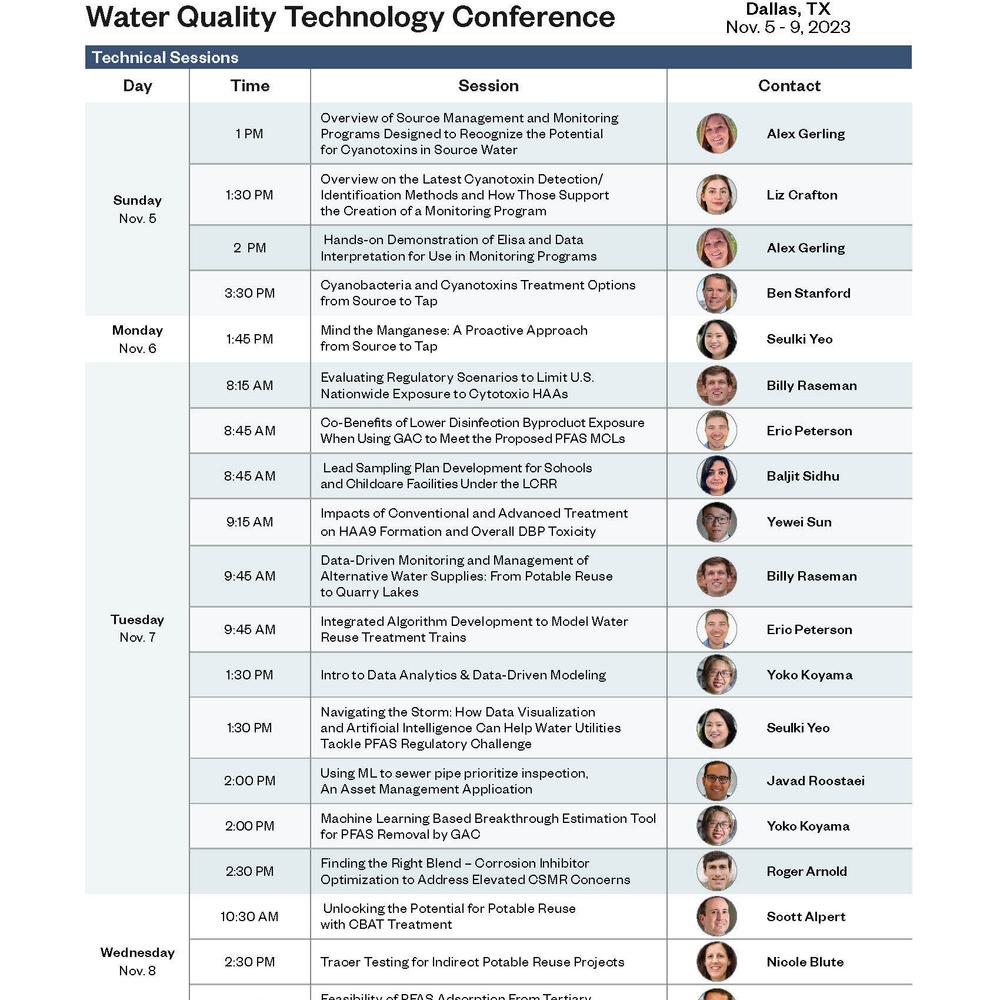Interactive Dashboard Delivery of an Integrated Water and Wastewater Utility Master Plan
Abstract
Integrated water and wastewater projections and planning efforts have evolved into a 'One Water' approach, whereby all water is considered valuable, to help municipalities meet demand requirements due to an ever-increasing population. Chatham County, North Carolina teamed with the Town of Goldston, the Town of Siler City, and the Town of Pittsboro, hereinafter 'the Partners', to develop a comprehensive water and wastewater utility master plan to facilitate a regional coordinated effort to meet their projected water and wastewater needs in both the short and long term. In lieu of a traditional report style master plan, this evaluation was holistic in nature and was developed as an adaptable decision-making tool using an interactive dashboard visualization framework. The dashboard was developed to communicate comparative cost and system capacity impacts of proposed alternatives, as well as facilitate adaptation of the master plan to dynamic future goals and planning efforts.
Introduction and Background
Chatham County is located in the Piedmont region of North Carolina just southwest of the large and rapidly growing City’s Raleigh, Durham and Chapel Hill, commonly referred to as the Triangle. The Triangle hosts the Research Triangle Park (RTP), which is home to many large technology and pharmaceutical companies such as IBM, GlaxoSmithKline and Cisco Systems. Northwest of Chatham County is the Triad, which includes Greensboro, High Point and Winston-Salem. Chatham County is anticipating rapid growth as the surrounding areas continue to grow and more people look outside the cities for available land and affordable housing.
The County’s Comprehensive Plan outlines their strategic plan to manage residential growth pressure and stimulate economic growth while maintaining a rural atmosphere and character. A result of the 2017 Comprehensive Plan was the action item to develop a county-wide water/sewer master plan to identify key infrastructure upgrades, regional connections, and water supply solutions. The development of an interactive dashboard in lieu of an industry standard static report is the first step taken by the Partners to address this action item.

Methodology
The master plan utilizes realistic demand projections for the service areas to develop an array of solutions for each of the Partners and the County as a whole. Opportunities for new or expanded treatment facilities, decentralized facilities, intra- and inter-county connections, distribution and collection system capacity improvements, and privately-owned facilities were considered, identified, assessed and incorporated into the master plan as appropriate and directed by the Partners.
Projections
Anticipated growth was projected at the residential and non-residential level utilizing available Transportation Analysis Zone (TAZ) data and US Census Data. This allowed for growth to be quantified at the residential and non-residential level. Population increases were distributed proportionally for each municipality and the County, and in accordance with the County's comprehensive plan. Service areas based on Partner were limited to the development corridors prescribed in the County's comprehensive plan. Growth projections were further refined based on input from each Partner and displayed so that the usage type (residential or non-residential) and associated timeframe could be selected as shown in Figure 1.

Learn more about the dashboards and master plan we developed for Chatham County.

In order to correlate the population projections to water demand, available billing data and treatment plant operations data were utilized to estimate the per capita demand within each service area. Water plant production data was utilized to establish total existing water demand. Future water usage for non-residential users was assumed to be proportional to current usage. Additionally, two "megasites," recognized by the Economic Development Partnership of North Carolina (EDPNC), were accounted for as part of the non-residential usage and modeled within the dashboard so the implementation year could be adjusted and the impact of the industrial development on projected capacity can be easily assessed (Figure 2). The "megasites" along with an additional industrial site are able to provide large advanced manufacturers dedicated property and water/wastewater infrastructure to promote growth within the County. Based on the projected growth related to these sites, as well as other commercial areas and estimated residential growth, future water demands were projected from the base year 2017 to an "ultimate" demand at year 2070 (complying with state regulatory planning guidance for 50-year water supply planning). Similarly, existing wastewater treatment plant flow data was used to establish wastewater demands proportional to the water demands for the planning period.
Multiple service areas included in the master plan are experiencing above average per capita water demand and per capita wastewater flows. This is due to several common issues such as leaks in the distribution system and ongoing infiltration and inflow challenges in the collection system. The upward demand pressure is anticipated to be at least partially offset by the adoption of low flow fixtures and water conservation practices. If the 2017 conversion factors are held constant through all planning years, the projections could vary significantly from reality the further out projections are made. Consequently, the dashboard tool was designed to allow the user to vary the per capita demand and wastewater flow by service area as more data becomes available as well as equip the user to perform a sensitivity analysis on the impact of changing the per capita gallon per day conversion factors (see lower right side of Figure 2).

System Characteristics
Summary characteristics were quantified for all the wastewater treatment and collection systems for each Partner. These characteristics include treatment capacity, treatment processes, system interconnections/capacities, and overall miles and diameters of existing collection system piping. ArcGIS information provided by the Partners, including water and sewer lines, were processed and the associated attributes were analyzed using the dashboard framework in Microsoft's Power BI as shown in Figure 3. Additionally, existing NPDES discharge permit limits and locations were added to the dashboard framework for reference.

Alternatives
Alternatives were developed using a wholistic approach to meet the Partners’ anticipated water supply demands. Alternatives included various combinations of expansion of existing facilities, construction of new facilities, potential interbasin transfers and interconnections with adjacent municipalities. Potential hydraulic limitations and necessary improvements in each service area to implement a proposed alternative were identified. Additionally, alternatives were developed for new wastewater collection and treatment to meet projected flows. These included several combinations of expansion of existing facilities, construction of new facilities, utilization of "decentralized systems," and transfers with adjacent municipalities. Areas with public sewer needs were identified and reviewed through this process to plan for future infrastructure. The dashboard was developed to facilitate a streamlined explanation of alternatives while providing sufficient data to make an informed decision on a path forward for each partner involved. The alternatives summary page for water and wastewater provides an illustration of the selected alternative, a brief summary, a detailed list of the infrastructure required and the associated present value capital cost as shown in Figure 4 for water alternative 5 (designated W05). Alternatives were split into two phases, with inputs for start and end years for each phase allowing the user to evaluate the cost benefit of deferring alternatives or components of alternatives to a later date.

In addition to capital costs, preliminary operations and maintenance (O&M) costs were developed and presented in the dashboard framework using conceptual level cost data for selected feasible alternatives. Because flows are projected to increase over time, O&M costs were calculated based on the projections for each Partner in a given year, summed over the life of the alternative then brought back to a present value for comparison. The Alternatives Comparison page, illustrated with water alternatives W03 and W06 in Figure 5 on the following page, allows the user to directly compare two alternatives and make an informed decision. The graphs assist the user in defining a start year based on flow projections and automatically updates and summarizes the present value capital and O&M costs for the selected alternatives.
A review of potential implementation issues including institutional arrangement issues, water quality concerns, permitting issues, land acquisition availability, and implementation schedule feasibility were considered. The treatment facility evaluation included conceptual based recommendations for potential upgrades to meet anticipated NPDES limits.
Adapting and updating the dashboard over time is not exclusive to the water demand and wastewater flow projections. The dashboard includes variables for capital and O&M costs that can be set and modified within a predefined range of values to simulate economic changes to further refine the master plan as shown in Figure 6.
Conclusions
By creating a master plan tool with an integrated dashboard framework like Microsoft's Power BI, the master plan includes powerful functionality to allow the Partners to quickly compare a variety of alternatives to meet their water and wastewater needs and visualize cost and timing impacts associated with each alternative. Furthermore, the master plan is designed to facilitate continuous updates and adaptations to refine decision-making for future alternatives. Adaptable conversion factors for water and wastewater flow, associated impact of cost for the various options, combined with the ability to select parameters for implementation dates and type, provided a fully interactive tool for the Partners.
The dashboard serves as a tool to tell an everchanging narrative and provides a unique alternative to industry standard practice of developing a report style master plan. Additionally, the ability to communicate necessary improvements, timing of those improvements and their financial impact to all stakeholders, such as town council members and public representatives, surpasses previously implemented approaches due to the working document nature of an interactive dashboard.










